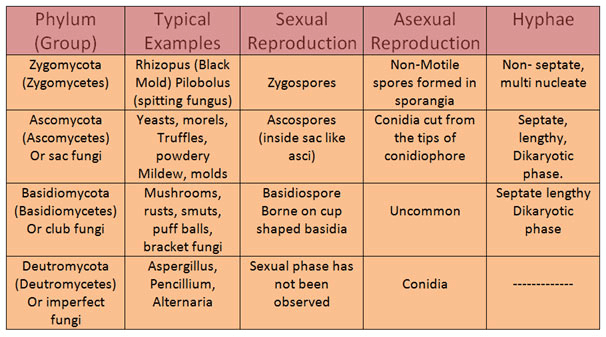Kin Fungus - Software Testing PDF Download
Introduction
- Fungi show a great diversity in morphology and habitat.
- Fungi are cosmopolitan.
- Fungi are found mostly in humus-rich soil.
- But in the presence of moisture, these can grow on leather, wood, pickle and bread.
- Some fungi live parasitically in plants, animals and the human body.
- Chloroplast is absent in fungi, so fungi are heterotrophs.
- Fungi obtain their own food from dead organic matter or living organisms.
Fungal Structure and Nature of Growth
- Except for the yeast, the body of a fungus is made of a number of elongated, tubular filaments known as hyphae (singular- hypha).
- The body of a fungus having filamentous branches of hyphae is known as mycelium.
- In yeast, the same cell may function in vegetative growth as well as in sexual reproduction.
- In most other fungi there are two distinct phases, vegetative and reproductive.
- The vegetative phase is also called the assimilative phase.
- During this phase, there is rapid absorption of nutrients from the substratum.
- However, the fungus is seldom noticeable due to two reasons:
(a) the Hyaline nature of hyphae.
(b) Occurrence of the major part of mycelium inside the substratum. - The reproductive phase is conspicuous in most of the fungi.
- The hyphae often become aerial.
- They form fructifications or fruiting bodies.
- In some cases, the spores produced during this phase are coloured.
Cell Structure
- The hyphae can be aseptate (= nonseptate) or septate. In aseptate hyphae cross walls or septa are not laid down at the time of nuclear division.
- The continued nuclear division makes the hyphae multinucleate.
- If the whole mycelium is without septa, the same is called coenocytic.
- In septate hyphae, cross-walls or septa are laid down after the nuclear divisions.
- The cells may have one, two or more nuclei.
- The binucleate condition may develop due to plasmogamy in sexual reproduction.
- In that case, uninucleated binucleate conditions are respectively called monokaryotic and dikaryotic.
- Septa are seldom complete.
- They are perforated.
- The septa contain plasmodesmata (Powell, 1974) or central pores.
- In many basidiomycetes, the central septal pore possesses barrel-shaped inflation.
- It is known as the dolipore septum. Simple septal pores occur in the ascomycetes and Deuteromycetes.
- However, may get partially plugged by membrane-bounded bodies and crystalline structures called woronin bodies.
- Septal pores allow the movement of substances between adjacent cells.
- This is useful for quick translocation of nutrients to all parts of the body, Hyphal or cell wall contains chitin or fungus cellulose along with other polysaccharides, proteins, lipids and a number of other substances.
- Fungal cellulose or chitin is a polymer of acetyl glucosamine.
- In some fungi, cellulose is also present, either alone (e.g., Phytophthora and many other oomycetes) or along with chitin.
- Fungal cells have a eukaryotic structure. Plastids are, however, absent.
- A membranous vesicle called a lomasome is found attached to the plasma membrane.
- The endoplasmic reticulum, vacuoles, mitochondria, ribosomes, microbodies, microtubules, etc. are typical. Dictyosomes are unicisternal.
- Food reserve is in the form of glycogen and oil.
- Special vesicles having wall materials occur near hyphal tips.
- They are called chitosomes. Nuclei are small as compared to other eukaryotes.
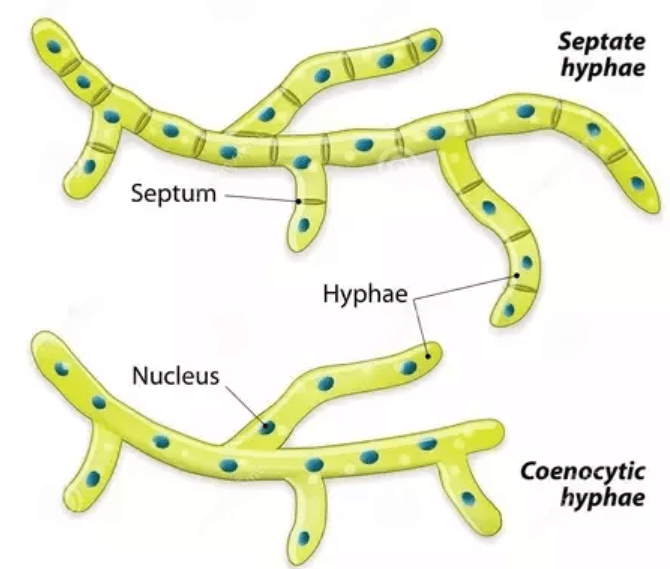
Reproduction in Fungi
Reproduction is of three types:
- Sexual
- Vegetative
- Asexual
Sexual Reproduction
- It involves the formation and union of two gametes or their nuclei.
- Sexual reproduction is absent in the artificial group of fungi called fungi imperfecti or Deuteromycetes.
- Depending upon the compatibility in sexual reproduction, fungi are of two types- homothallic and heterothallic.
- In heterothallic forms, sexual reproduction involves fusion between two genetically different mating types. In homothallic forms fusion different occurs between genetically similar types.
- Fusion involves the union of cytoplasms as well as nuclei.
- The former is called plasmogamy while the latter is called karyogamy.
- In higher fungi, karyogamy is delayed and occurs just before meiosis.
- In the stage intervening between plasmogamy and karyogamy, the cells often contain two nuclei or dikaryon (n + n).
- Such cells are called dikaryotic cells.
- The phase is known as dikaryophase.
- In such fungi, the life cycle is completed in three phases instead of two-haplophase, dikaryophase and diplophase (2n).
- Meiosis occurs in diplophase. Fungi show a progressive reduction in sexuality.
- Sexual reproduction occurs by five methods:
(i) Planogametic Copulation: Flagellate gametes differentiate and fuse. Fusion may be isogamous or heterogamous. Heterogamous fusion maybe by anisogamy (gametes different in size and structure) or oogamy. In oogamy, the male gamete is generally small and flagellate while the female gamete is large, food-laden and non-flagellate.
(ii) Gametangial Contact: There are two types of sex organs, male antheridia and female oogonia. Male gametes or nuclei are transferred to the oogonium through fertilization.
(iii) Gametangial Copulation: It is a type of conjugation in which both the types of gametangia fuse directly resulting in the formation of a zygospore.
(iv) Spermatogamy: Here a small male cell or gamete is carried to the receptive region or trichogyne of the female sex organ.
(v) Somatogamy: Distinct sex organs are absent. Sexual reproduction involves the
fusion of two hyphae or cells.
Heterothallism: The phenomenon of having two genetically different and compatible sexual strains in separate thalli is known as heterothallism. It was discovered by Blakeslee in 1904.
Vegetative Reproduction
- It occurs by fragmentation, budding, fission, sclerotia and rhizomorphs.
- Sclerotia are perennating bodies made up of compact masses of hyphae.
- They grow under favourable conditions to produce new mycelia, e.g., Claviceps.
- Rhizomorphs are rope-like twisted subterranean masses of hyphae with well-defined apical growing points.
- They pass the unfavourable periods in a dormant stage. Under favourable conditions, each rhizomorph gives rise to a new mycelium.
Asexual Reproduction
- It occurs through the formation of spores.
- Spores are single-celled propagules that separate from the parent organism and can get dispersed. They may be motile or nonmotile, naked, thin-walled or thick-walled.
- Some spores are produced after meiosis.
- They are called sexually produced spores or meiospores, e.g., ascosporės, basidiospores.
- Other spores are called mitospores or asexually produced spores.
- They resemble the parent body in having the same sets of chromosomes or genomes, e.g., zoospores, sporangiospores, chlamydospores, oidia, conidia, etc.
1. Zoospores: They are motile spores that occur same Phycomycetes, e.g. Phytophthora, Albugo, Achlya. The spores are commonly naked. 1-2 flagella are borne anteriorly, posteriorly or laterally. Flagella help the zoospores to swim in aquatic habitats for proper dispersal.
2. Sporangiospores: They are non-flagellate spores that develop inside sporangia, e.g. Mucor, Rhizopus. Sporangiospores are usually dispersed by air currents. Therefore, they are produced in large numbers.
3. Chlamydospores: They are thick-walled perennating spores that develop at places along the hyphae by the accumulation of protoplasm, rounding off and secretion of thick wall
4. Oidia: They are formed under conditions of excess water, sugar and certain salts. Oidia are individual cells separated from hyphae. They multiply by budding. Oidia often take a part in fermentation, e.g., Rhizopus.
5. Conidia: They are nonmotile exogenous spores that develop through abstriction at the tips or sides of special hyphae called conidiophores, e.g. Penicillium, Aspergillus
6. Ascospores: They are a type of nonmotile meiospores that are produced inside
special sacs called asci (singular- ascus). An ascus often contains 8 ascospores because meiosis is accompanied by one mitosis. Ascospore formation is characteristic of class ascomycetes.
7. Basidiospores: Basidiospores are nonmotile meiospores that are formed exogenously, on outgrowths of a club-shaped structure called a basidium. Basidiospores are characteristic of basidiomycetes.
8. Binucleate Spores: The spores are meant for multiplying the dikaryotic mycelium. They are, therefore, themselves dikaryotic, e.g., aecidiospores, uredospores. Both these types of spores are found in rusts, e.g., Puccinia or Wheat Rust. Another type of dikaryotic spore is teleutospore or teliospore. It is specialized to produce a basidium.
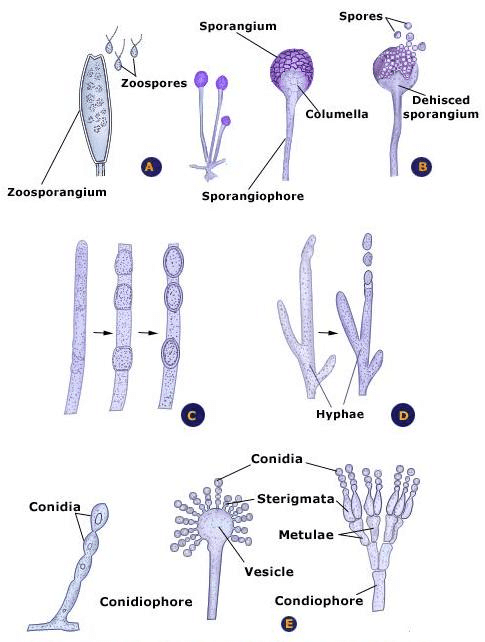 Types of Spores
Types of Spores
Classification of Fungi
A number of criteria are used for classifying fungi. The important ones are:
(a) Morphology or from structure and appearance of fungus. Morphology of assimilative (vegetative) mycelium is useful in only a few cases. Morphology of reproductive structures exhibits more variations and is hence important in fungus classification.
(b) Types of spores and their dispersal.
(c) Life cycle.
(d) Physiology.
(e) Biochemistry. The follows:
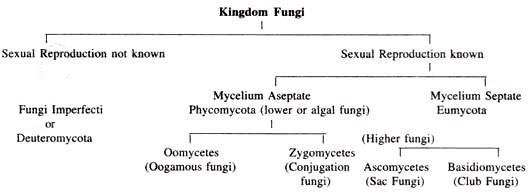
Phycomocota or Phycomycetes: Lower or Algal Fungi
- The Fungi are characterized by aseptate coenocytic hyphae.
- Asexual reproduction occurs by zoospores or aplanospores produced endogenously inside sporangia.
- Sexual reproduction is isogamous or heterogamous.
- Heterogamous reproduction is of two types, anisogamous and oogamous.
- Phycomycota or Phycomycetes is divisible into two groups, oomycetes and zygomycetes.
Oomycetes: The Oogamous Fungi
1. The mycelium is coenocytic (multinucleate and aseptate).
2. Hyphal wall contains cellulose and other glucans in many members. In some chitin or fungus cellulose is also present.
3. Asexual reproduction involves the formation of spore-containing sacs or sporangia. In aquatic conditions the sporangia produce zoospores. In terrestrial conditions the sporangia often behave as spores, equivalent to conidia. Because of it, the sporangia are often called conidiosporangia.
4. Zoospores are generally biflagellate with heterokont flagellation in which one flagellum is smooth while the other is of tinsel type (having fine surface outgrowths called mastigonemes).
5. Gametes are usually non-flagellate.
6. Sexual reproduction is by gametangial contact in which the male sex organs or antheridium pass its product into the female sex organ or oogonium through a fertilization tube.
7. The product of sexual reproduction is oospore.
Examples
A. Late Blight:
- Phytophthora infestans cause late blight of Potato and occasionally of Tomato as well.
- Blight is the appearance of brownish to black dead areas.
- They are first formed on the margins and tips of leaflets.
- Later on, the whole foliage becomes blighted.
- Tuber yield is reduced.
- The surface of the tubers also shows blighting.
- The Irish famine of 1845-1847 was caused by the late blight of Potato.
B. White Rust:
- It occurs in crucifers and is characterized by the appearance of irregular white blisters containing conidiosporangia on the leaves and stems.
- White rust is caused by Albugo candida (= Cystopus candidus)
Zygomycetes: The Conjugation Fungi
1. It is a class of terrestrial fungi that are mostly saprotrophic, rarely parasitic.
2. The mycelium is coenocytic (multinucleate, aseptate).
3. Hyphal wall contains chitin or fungus cellulose.
4. Motile cells (zoospores and planogametes) are absent.
5. Mitospores are nonmotile. They are called sporangiospores as the spores are formed inside sporangia are borne at the tips of special hyphae called sporangiophores.
6. Sexual reproduction occurs through gametangial copulation or conjugation. of it, zygomycetes are also called conjugation fungi.
7. The gametes are multinucleate and are called coenogametes.
8. Sexual reproduction produces a resting diploid spore called zygospore. Because of the presence of zygospores, the group of fungi is called zygomycetes. Zygospore differs from oospore in that during its formation a distinct large food-laden nonmotile female gamete is not produced.
9. Zygospore does not give rise to new mycelium directly. Instead, it produces a new sporangium called germ sporangium (previously called zygosporangium). Germ sporangium forms meiospores called germ spores.
Examples
A. Squirting Fungus: Pilobolus crystallinus is a coprophilous or dung mould in which mature sporangia are thrown away up to a distance of 2m.
B. Rhizopus and Mucor: Rhizopus stolonifer (= R. nigricans) is popularly known as black bread mould. Mucor caninus or M. mucedo is coprophilous. It is also called dung mould. Rhizopus and Mucor are the common saprotrophic fungi that attack a variety of foodstuffs. Soft rot or leak disease of Strawberry, Apple, Sweet Potato, etc. is due to Rhizopus. Mucor pusillus causes infection of internal organs in human beings. Absidia corymbifera causes bronchomycosis.
Both Rhizopus and Mucor species (e.g., Rhizopus oryzae, Mucor javanicus) are used in alcoholic fermentation. The two also produce a number of organic acids like citric acid, lactic acid and fumaric acid.
Ascomycetes - The Sac Fungi
1. Ascomycetes is a class of diverse fungi numbering over 30,000 species (Ingold, 1967). They include pigmented moulds (brown, green, blue, pink), powdery mildews, yeasts, cup fungi, morels and truffles. Nutritionally they are saprotrophic, decomposers, coprophilous or parasitic.
2. The mycelium consists of septate hyphae. Yeasts are an exception in that they are basically unicellular. They may, however, form a short temporary filamentous structure called pseudomycelium.
3. The septa possess central pores called septal pores. The pores allow communication between adjacent cells. Septal pores show plugging of different types.
4. Cell wall contains chitin or fungus cellulose.
5. Motile structures do not occur in the life cycle.
6. In yeasts, asexual reproduction occurs through budding and fission. Oidia stage, similar to yeast, sounds in some other ascomycetes as well.
7. In the majority of ascomycetes, the common mode of asexual reproduction is through. the formation of conidia (singular- conidium). Conidia are nonmotile fungal mitospores that are produced exogenously for more tips and sides of hyphae called conidiophores.
Conidia are often coloured brown, green, blue or pink. They provide colouration to the fungus. Greenish and bluish growth on bread, citrus fruits and old leather are due to moulds belonging to ascomycetes e.g., Penicillium, Aspergillus.
8. Conidiophores may be branched or unbranched, scattered or aggregated to form structures like acervulus, synnema, sporodochium, etc.
9. Sexual reproduction takes place through the fusion of sex cells, somatic cells, gametangial contact between an antheridium and ascogonium, and autogamy.
10. Fertilization occurs in two steps, plasmogamy and karyogamy. Karyogamy is delayed after plasmogamy. A new transitional phase appears in the life cycle. It is called dikaryophase, The cells of dikaryophase are called dikaryotic cells. Each such cell possesses two nuclei (n+n).
11. Some dikaryotic cells function as ascus mother cells. The latter act as the seats of both karyogamy and meiosis. This converts the cells into asci (singular- ascus).
12. Ascus is a sporangial sac peculiar to ascomycetes. 4-8 haploid meiospores named ascospores are produced internally in each ascus. In most cases, half the number of ascospores belong to one mating type while the other half belongs to the second mating type.
13. The asci may occur freely or get aggregated with dikaryotic mycelium to form fructifications called ascocarps. Ascocarps are of many types: cup-like (apothecium, e.g., Peziza), flask-shaped (perithecium e.g., Neurospora), elongated with a slit (hysterothecium) or closed (cleistothecium e.g., Penicillium). The fructifications of some ascomycetes are edible and considered delicacies, e.g., morels, truffles.
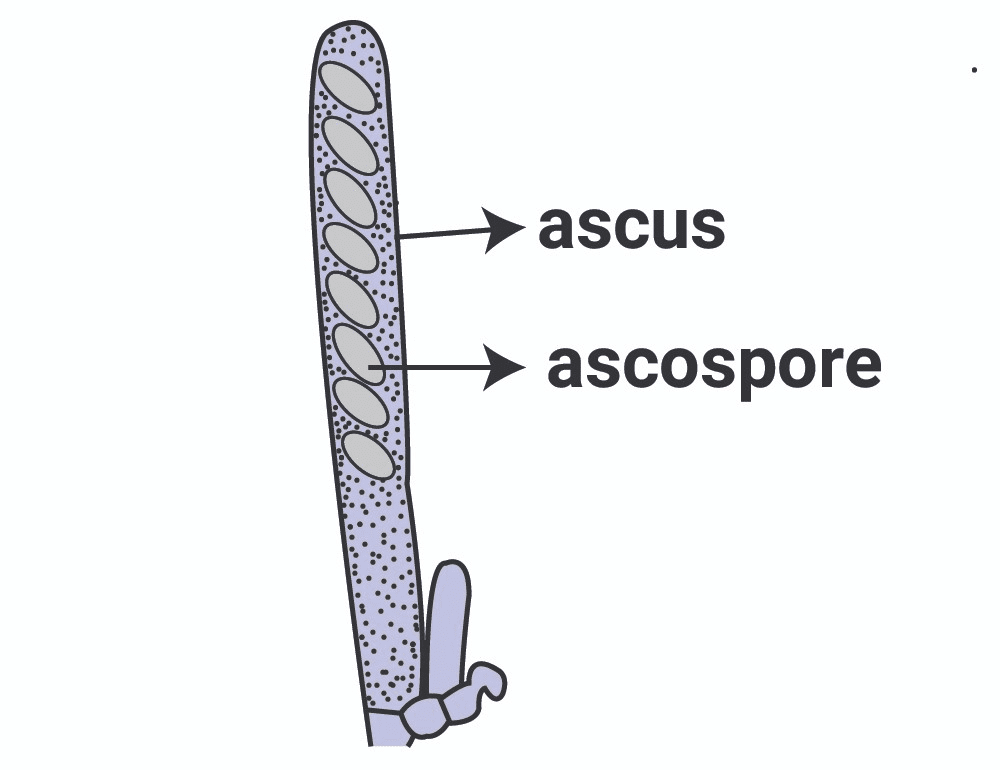
Basidiomycetes - The Club Fungi
1. Basidiomycetes are the most advanced and most commonly seen fungi as their fructifications are often large and conspicuous, e.g... mushrooms (gill fungi), toadstools, puffballs, bracket fungi, etc.
2. The class contains about 25,000 species.
3. Basidiomycetes are among the best decomposers of wood. Only a few insects can compete with basidiomycetes in decomposing hardwoods and woody structures of trees. Basidiomycetes are able to decompose both cellulose and lignin. Lignin is not metabolized by most other fungi and even bacteria. For decomposing wood, these fungi secrete cellulose and lignin digesting enzymes. The enzymes create spaces in the wood for hyphae to pass inwardly. It is because of this that we sometimes observe toadstools and mushrooms come out of wooden structures. Gonaderma species causes decay of wood even of standing trees.
4. Motile structures or cells are absent.
5. Mycelia are of two types, primary and secondary. Primary mycelium contains monokaryotic cells, that is, cells with single haploid nuclei (n).
6. Monokaryotic phase or primary mycelium may multiply by oidia, conidia-like spores
and pycniospores. Dikaryotic mycelium does not multiply by asexual spores.
7. There is often differentiation of two mating types, (+) and (-).
8. Sexual reproduction does not involve organs. Instead, plasmogamy (fusion of protoplasts without fusion of their nuclei) occurs by fusion between basidiospores and other monokaryotic spores, between a spore spermatium and a hypha or between two hyphal cells of primary mycelia.
9. Karyogamy is delayed for The intervening phase is called dikaryophase. It produces a new mycelium called secondary mycelium which is dikaryotic (n+n).
10. Secondary mycelium is long-lived. It consists of profusely branched septate hyphae. 11. Septa possess dolipores or central pores with barrel-shaped outgrowths.
12. Hook-shaped outgrowths are found on the sides of septa. They are called clamp connections. Clamp connections are meant for the proper distribution of dikaryon at the time of cell division.
13. Secondary mycelium can perennate in the soil or wood by means of sclerotia (often rounded or ellipsoid firm masses of hyphae) or rhizomorphs (root-like aggregation of hyphae with well defined apical meristems).
14. Dikaryophase or secondary mycelium may multiply by different types of spores chlamydospores, aecidiospores, uredospores, teleutospores, etc.
15. Karyogamy and meiosis occur in club-shaped structures known as basidia (singular- basidium). The name of the class is based on them. A basidium may be aseptate (holobasidium) or septate vertically or transversely (phragmobasidium).
basidium commonly produces four meiospores or basidiospores exogenously at the tips of fine outgrowths called sterigmata.
17. The fungi may or may not produce fructifications called basidiocarps. The basidiocarps vary from microscopic forms to large macroscopic structures. Some puffballs and brackets can be over 50 cm in diameter.
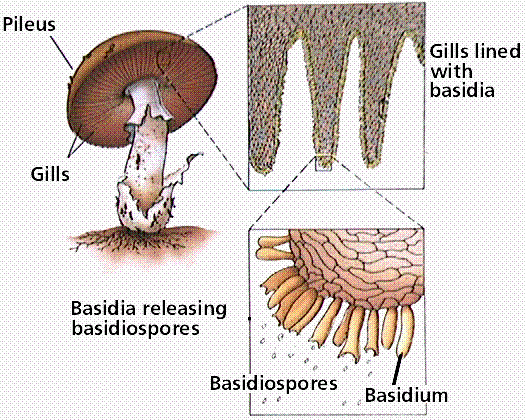
Deutromycetes - The Fungi Imperfecti
1. Deuteromycetes is an artificial class of fungi that have been created to include all those fungi in which the sexual stage is either absent or not known.
2. Some of the Deuteromycetes are unicellular like yeasts. They are often studied along with the latter.
3. The mycelium is usually septate. Coenocytic forms are not known. Clamp connections, typical of basidiomycetes, are absent.
4. Asexual reproduction often occurs by conidia some other types of spores. In some cases even asexual spores are absent.
5. It is believed that most members of deutromycetes are actually ascomycetes in which sexual reproduction is either absent or yet to be discovered.


